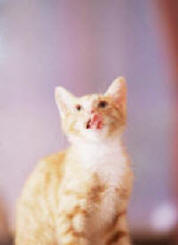What
is hand feeding?
Hand Feeding™
is a 1-2 week behavior modification
technique that accomplishes
several goals:
- The
pet learns the owner is the
only source of food
-
The pet learns to be calm
and gentle or the food goes
away
-
The pet learns to "earn"
individual pieces of food
by responding to commands
-
The pet learns the human hand
coming near their food bowl
is a good thing
-
The pet learns a closed hand
might contain food (so perform
commands for any closed hand)
-
The pet learns a new routine
that builds trust and respect
for human hands
What
do I hand feed?
Temporarily, stop any treats, canned
food or scraps, and feed only
dry kibble. If the pet refuses
to eat dry kibble, allow the
pet to decide to fast, but offer
dry kibble, one unit at a time,
anytime the pet seems hungry.
Transition to twice daily meals,
preferably from food puzzles.
During this or any behavior
modification strategy, do not
allow more than a 10% loss in
body weight, and medical issues
trump behavioral strategies.
How
do I hand feed?
Try to do at least one minute
of hand feeding every meal.
Put one kibble at a time into
a closed hand, and gradually
open it to reveal the food to
teach the pet the closed hand
might mean food. Feed as many
pieces of kibble as you have
time for, and then begin to
drop pieces into the pet's
food dish or put the rest in a
puzzle.
|
Give
the remainder of the daily
ration following hand
feeding. If any
food is left uneaten, decrease the next
meal by that amount. The
pet should lick the bottom
of the bowl at least once
daily if not being over-fed. |
What
if the pet "grabs"
the food or bites at my hand?
Place the food piece in your
closed hand. If the pet is gentle
and then slowly open your hand
and allow the pet to take the
food. If the pet is unruly,
rough or demanding, close your
hand around the food, or if
that doesn't work, pull
your hand away, then slowly
re-present. If the pet is still
rough, turn away, stop the hand
feeding session and try again
in 5 minutes. The first goal
for the pet is to learn that
being gentle and respectful
is what "works"
to get food.
How
does the pet "earn"
food? (A = when
the pet is working)
Once the pet is readily accepting
kibbles one at a time, begin
to make the pet "work"
for each piece. This might mean
asking for a Sit, Down or Wait
before the pet can have the
kibble.
If
the pet has chosen to fast 3
days, or if 10% weight loss
is reached, then it is okay to
begin to hand feed items of
higher taste stimulus, such
as freeze dried liver, or pieces
of chicken or hot dog. Continue
to feed dry kibble twice daily.
Once
the pet will quickly and happily
do simple commands, move the
operation to a different room
of the house, or add new commands.
This might be a good time to
schedule a private in-home training
visit, or enroll in a group
training class if you find
yourself using the same commands
repeatedly.
When
can I phase out hand feeding?
(A = passing a test)
-
Will the pet's nose
follow a closed hand?
-
Will the pet take the food
gently?
-
Will the pet wait before taking
food when asked?
-
Will the pet readily perform
any command requested?
|